Abstract
Malaysia is not entirely spared from regular water shortages although it is located in a water rich region. The authors’ previous study clarified that rainwater harvesting (RWH) might be one of the possible priority measure for promotion of water conservation. In line with such recognition, it is necessary to understand the relevant stakeholder’s perceptions and attitudes towards the RWH practice. Thus, a set of structured interviews and questionnaire surveys were conducted among the stakeholders. Selangor, the most developed state in Malaysia was chosen as a case study. Herein, the stakeholders consist of (i) the fostering-side, namely the policy-makers, equipment-makers and NGOs/community leaders, and (ii) the accepting-side, namely the users and expected users of RWH. It is verified that the fostering-sides are generally in the medium level of participation. They are willing to support RWH on condition that accepting-sides become more positive to cooperate for RWH adoption. The accepting-sides are commonly in the low level of awareness. They seem to show more positive response when presented with proposal of low-cost RWH. To overcome the deadlock relationship between the two parties, several approaches that can be beneficial to both parties are proposed such as income tax and import duty exemption for rainwater harvesting system installations and reward-based RWH applications.
Keywords: Accepting-sidefostering-siderainwater harvesting (RWH)water conservation program (WCP)
Introduction
Most of the South East Asian countries, although under monsoonal wet climate, is in dire need to embrace water conservation measures due to rapid urbanization that instigate declination of water reserves. The tremendous impacts on the adequacy of water supply are primarily attributable to pollution in water resources development basin and prevailing of high water consumption life-style (Bates, Kundzewicz, and Wu, 2008); (Chan, 2009; OECD, 2017).
Tokyo has successfully promoted ‘Water Conservation Program’ (WCP) since 1973. The WCP incorporates both (i) supply-side control (leakage and non-revenue water reduction) and (ii) demand-side control (introduction of water-saving devices, wastewater recycling, rainwater harvesting, and raising of people’s awareness). The authors’ preceding study verifies that such WCP contributes to reduction of per capita water consumption in net-basis by about 160 l/p/d or 81l/p/d in gross-basis (19% reduction) excluding 79 l/p/d increment mainly due to extension of nuclear family. The weight is 53% and 47 % for supply-side and demand-side control, respectively (Nafisah, Matsushita, and Okada, 2011). Herein, it is assumed that Tokyo's schematic WCP could be used as a workable blueprint for rapidly urbanized mega-cities, such as Selangor, the most developed state in Malaysia.
Problem Statement
Selangor, with area of 7,956 km2 has population over 6 million. The population density is approximately 630 people/km2. The average rainfall is 2,500 mm/year. Water resources in Selangor became very tight due to increment in water demand and the decrement in internal water resources capacity. Water problem in Selangor is more crucial compared to other states in Malaysia (Basheer, Hanafiah, & Abdulhasan, 2017); (Sukereman & Suratman, 2016).
By reflecting Tokyo’s WCP to Selangor, rainwater harvesting (RWH) is identified as the highest priority measure from demand-side control toward future water conservation based on resisting/driving factor analysis. RWH potential analysis in Eastern Petaling Jaya region in Selangor reveals that water consumption reduction capacity up to 22 L/p/d or 6% reduction rate could be materialized by the full-scale RWH application (Nafisah, Matsushita, & Suenobu, 2011). It is suggested that better understanding of stakeholder’s perceptions and attitudes is needed towards full RWH application in the state.
Research Questions
In Malaysia, RWH was introduced around 1999. Various policies and initiatives has been promoted by the government to implement RWH. Given that RWH is likely to become a viable solution to address the shortage of clean water resources in Malaysia, a big question today is if this alternative accepted or will be accepted by relevant stakeholders? How do they fare in terms of knowledge and awareness in RWH? What are their level of involvement towards making RWH a significant measure to conserve existing water resources? In addition, the authors prepared a conceptual plan to boost RWH implementation in Malaysia. Is this plan feasible? To answer these questions, this study is perceived as very important.
Purpose of the Study
This social research aims to explore the multi-stakeholders’ receptivity towards RWH for the promotion of water conservation in Selangor. The study focuses to investigate the level of knowledge, acceptance, involvement and willingness to participate in the rainwater harvesting program among the relevant parties. The study also aims to gauge the feasibility of the authors’ proposal on conceptual plan to enhance RWH adoption in the state.
Research Methods
Two survey methods were employed in this study to investigate the multi-stakeholders’ perceptions and attitudes towards the implementation of rainwater harvesting as supplemental water resources in the context of urban practice. These are namely the structured interviews and questionnaire surveys which are used to gather data from two major groups of respondents. The respondent groups comprised of (i) the fostering-side, namely the policy-makers, equipment-makers and NGOs or community leaders; and (ii) the accepting-side, namely the end-users. For the fostering-side, structured interview was employed since the number of respondents is small and more detailed information is needed. Whereas, for the accepting-side, the questionnaire survey was employed as the sample size are larger. It was also designed to have more straightforward questions that require shorter time to answer.
Structured interviews for the fostering-side
The structured interviews were conducted by interviewing three sub-groups of stakeholders that are responsible to foster the RWH implementation in Selangor. A set of an exact same questions comprising both close-ended and open-ended queries were asked in the same order to all the stakeholders in order to compare and analyse the responses in the same context. The questions were divided into 3 sections. Section
Questionnaire surveys for the accepting-side
Several relevant studies were used as guidelines for drafting the survey questionnaire. Among them are a survey on public opinion on RWH in Bangladesh by (Karim, Shelly, & Biswas, 2005), a survey on attitudes to conservation and water consumption by (Willis, Stewart, Panuwatwanich, Williams, & Hollingsworth, 2011) and a pilot study by (Ward, Butler, & Memon, 2008) which surveyed RWH users in the UK. However, the pilot study in the UK is most relevant for many part of this survey since the required information deemed to be very similar. For this study, the sample selected is a representative sample. There are two ways of deriving representative samples for research surveys i.e. probability sampling and non-probability sampling. Non-probability or purposive sampling is much more widely used (Palinkas et al., 2013). Controls are placed on the types of respondents, specifically looking for different types of respondents. The purpose is to ensure that the chosen sample is correctly balanced and represent the intended user group. For this study, non-probability sampling was used.
During the interview sessions with the fostering-side, some information that led to the existing RWH end-users were obtained. This information was helpful in selecting potential respondents for the accepting-side. Other respondents were randomly selected. Questionnaires were given in person to respondents and were asked to complete the form right away. They were also given the opportunity to ask about any questions that are unclear to them. The survey was conducted in-person by visiting private houses and other public places. Since the survey was performed in-person, while choosing potential respondents, attention was given on balance between sex, ethnicity and age groups in order to obtain representative sample. Thus, the diversity of the respondents can be maintained. The survey was carried out on 122 respondents.
Findings
The data gathered from both structured interviews and questionnaire surveys were analysed and the findings are reported and discussed in the following subsections.
Findings of structured interviews with the fostering-side
Answers sought are whether they have fully, partially or never implemented any such activities. If they claimed to have performed any RWH-related activity, they were asked about the details of those activities and details about the target group on the RWH activities they undertook. This question was set aside for the respondents who claimed to have not perform any RWH-related activities. Answering choices given were positive, negative, and a mixture of both. Respondents were also required to explain their answer. The next question was on the challenges in implementing the RWH. Some suggestions were also presented for this question such as the cost and public acceptance.
By analysing the respondents’ answers, it was found that all the respondents had been involved in implementing some RWH-related activities except for Selangor Mosque Youth Association. However, they admit that it was only partial involvement. For example, the ministry which is supposed to implement RWH in a compulsory manner have yet to successfully implement it throughout the country (Bernama, 2014). PKNS has implemented RWH pilot project for a new housing development scheme, but it was discontinued due to the failure of the first project (Star, 25 Jun 2013). DID has partially performed some RWH related activities such as the preparation of RWH guidelines and financial assistance to fund limited numbers of RWH projects. NAHRIM was involved in research on water quality and design of RWH system, however it is still in its initial stage.
Whereas, the equipment-makers have yet to successfully produce local RWH equipments particularly the first-flush diverter and the automatic control system. Those equipments are currently being imported from foreign countries. Among NGOs and community-leaders, the involvement mainly remains at the early stage. The campaigns, if any were too localized with focus only on a few RWH projects and a few target groups. RWH special promotion at national level remains to be done. All the respondents seem to reflect what they have done so far is only considered as a pilot project and partial involvement.
With respect to the target groups feedbacks, for anything that involves regulation on compulsory practice or related matters, the response was generally negative especially among the developers and end-users. A few respondents also stated that they never receive any form of response or feedback from the target groups since the target groups do not have sufficient information to give any reaction due to lack of knowledge on RWH. Whereas if the activities involved support to RWH pilot projects or campaigns, the responses from the target groups varies from positive, negative and mix of both depending on the success rate of these activities. For example, PKNS RWH project that had failed received a negative feedback from the end-users, while the RWH project in Ampang mosque by DID received a positive response mainly because the end-users manage to reduce their water bills up to 34% each month since its implementation (Bernama, 2014).
The equipment-makers testified that the feedbacks from their target groups are a mixture of both positive and negative. This likely depends on the users’ level of satisfaction towards the product. One common feedback given is that while the RWH products sold by them was found to meet satisfaction level in terms of function, they are yet to achieve the aesthetic standard that users expect.
With regards to the challenges the respondents face to implement RWH, the responses received includes relatively higher costs of the RWH system, low level of public acceptance, low water tariffs regime, low level of awareness among the public, the aesthetic issues, the technical issues, enforcement setbacks and political intervention. These challenges must be solved in appropriate manner to set off greater opportunities to promote RWH.
DID intends to propose RWH model projects in universities in addition to improving the previous prepared RWH guidelines. DD Techniche Ltd. intends to promote their RWH products to local authorities and other relevant consultants. AkayConsult Malaysia plans to initiate low-cost product development. DJROA would like to participate fully in RWH implementation especially by promoting to the local community members.
The subsequent question aims to comprehend the respondents’ views on the proposed conceptual plan prepared by the authors to promote comprehensive application of RWH in the state. Figure
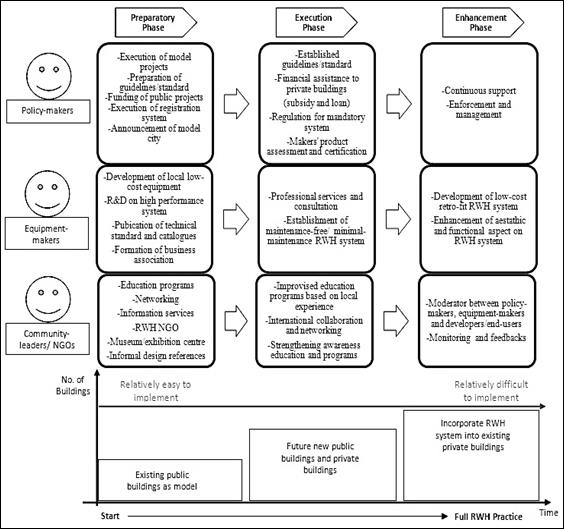
All respondents strongly agreed that the conceptual plan is highly feasible. They were also willing to implement the proposal. A few respondents gave suggestions on approaches that they may undertake in order to implement the proposal. Among them, PJCC claimed that they may appoint a panel of contractors and suppliers to establish RWH business association. DID stated that the proposal could be a reference for the application of RWH. They suggested improvements to the proposal in terms of presenting the timeline for each phase. However, the realistic timeline allocation requires further detailed study.
AuraLite Sdn. Bhd. proposed that the policy-makers should prepare the Malaysian standard for RWH products to ensure that the equipment-makers could produce low-cost product that still maintains minimum required functionality and quality standard. This suggestion is in line with the authors’ recommendations on product assessment and certification. The company is also willing to cooperate with NAHRIM for research on rainwater quality. The other respondents highly support the proposal without giving any additional recommendations.
Findings of the questionnaire surveys with the accepting-side
In this study, the awareness on RWH is measured by taking into account on the respondents’ level of knowledge on RWH and their perception toward the suitability of harvested rainwater for several listed purposes. From the analysis, it is derived that the RWH-users and non RWH-users level of knowledge are different. In general, it is concluded that respondents have low level of awareness on RWH particularly among the non-RWH-users as shown in Figure
The analysis on the perceived suitability level of RWH for several listed purposes clearly reflects a difference of opinion between RWH-users and non-users as shown in Figure
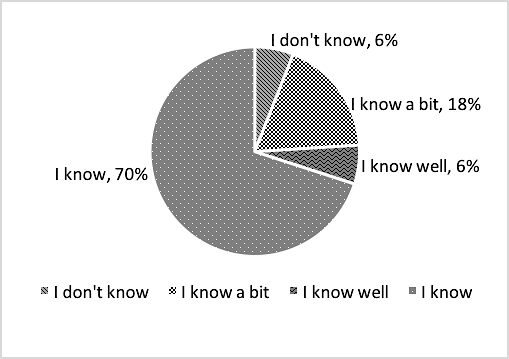
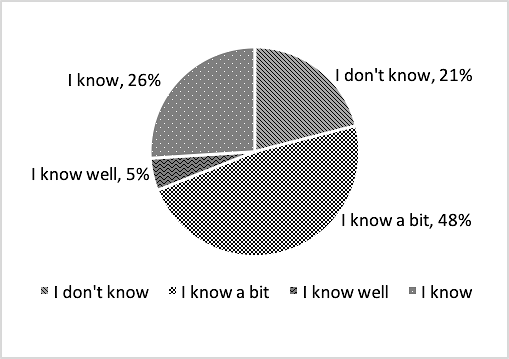
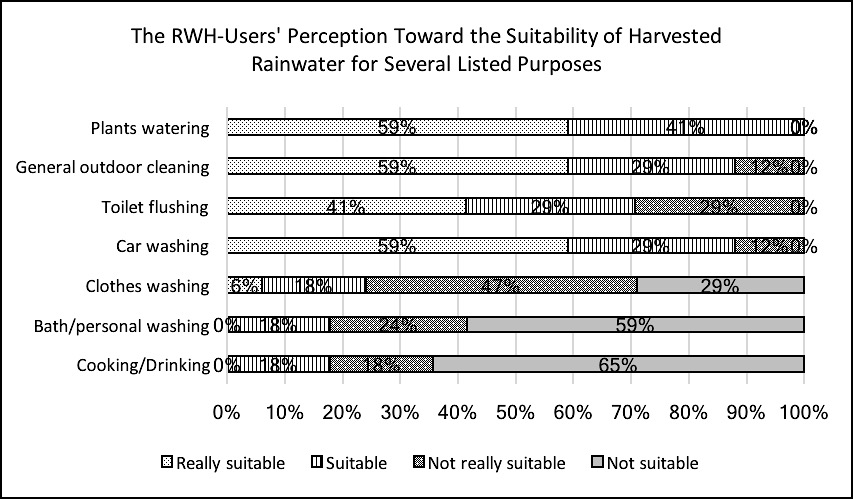
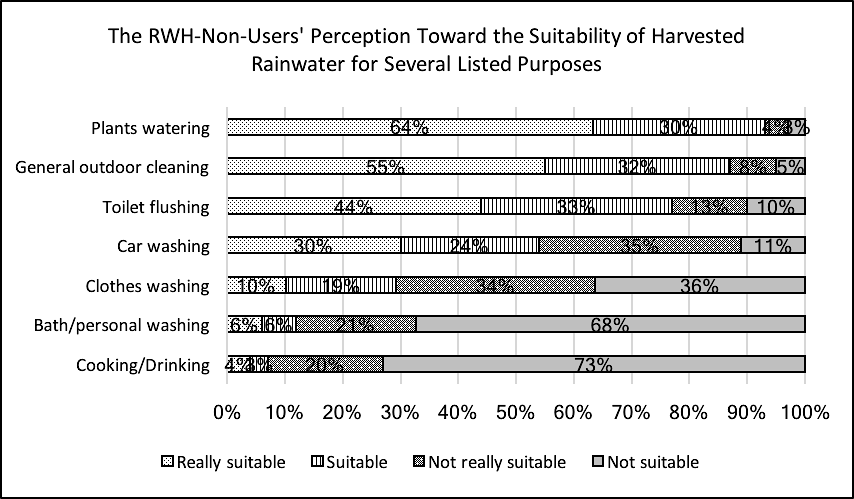
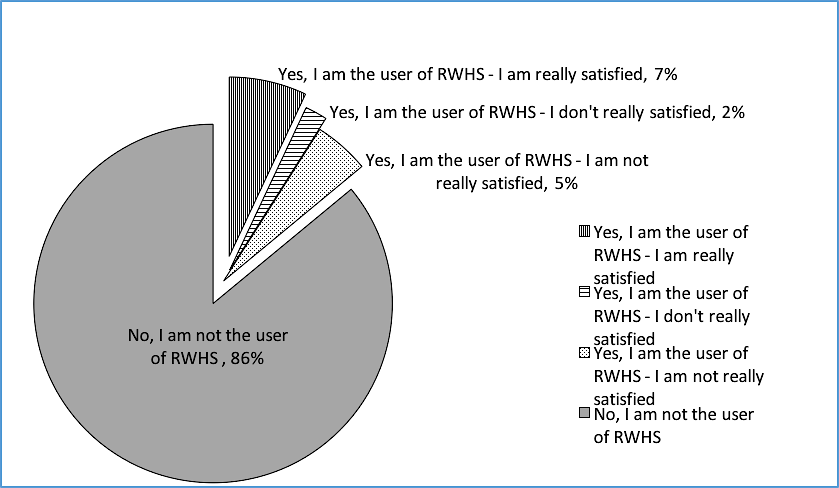
In subsequent question, respondents were asked to rank the factors that will influence them to implement RWH in a sequence according to the priority. It turns out that the factors influencing RWH-users and non-users were quite different. For RWH-users, the most influential factors are cost reduction in regards of water bill, availability of subsidy schemes for RWH, their impact and contribution to the environment and government requirements and regulations to implement RWH. The factors that concern them the most are related to economy, followed by social. Technical factors do not give much influence. This might be because they may already have information related to technical matters since they have experience using RWH. Economic factors seem to be the most important factor since initial cost for existing RWH system is quite high. Therefore, they expect economical returns for their investment on RWH.
For non-RWH-users, the order of influential factors seems balanced between the economic, social and technical factors. This may be because they do not have any prior exposure related to RWH, thus a variety of different factors are taken into consideration. However, since these respondents do not have prior knowledge or experience on RWH, the responses are deemed as solely personal perception.
Summary of the findings
By analysing the surveys conducted on both fostering-side and accepting-side, some important results were discovered. It was found that the stakeholders from the fostering-side had already been involved in intermediate level of RWH implementation. Among the efforts include involvement in RWH pilot projects, preparation of RWH guidelines, attempts toward the enforcement of RWH by the introduction of regulation on compulsory practice, introduction of RWH-products in the domestic market and encouragement on RWH implementation. However, the efforts seem to be insufficient since comprehensive RWH application has not been materialized up to date. The stakeholders admit that they have not fully executed RWH related activities primarily due to lack of co-operation from the accepting-side. A number of further approaches and steps should be taken to ensure the success of RWH practices in the state. The proposed conceptual plan for comprehensive RWH adoption by the authors could become the reference as all the respondents recognized the feasibility of the proposal on condition that the accepting-side would co-operate.
Meanwhile, among the accepting-side, only a small number of respondents have implemented RWH. Half of those RWH users have little or no satisfaction on RWH due to factors such as the incomplete RWH system installation, aesthetic issues and mosquito breeding problem. On the other hand, as 86% of respondents were never involved in RWH, their level of knowledge on RWH is next to none. However, it appears that a number of factors could influence in encouraging the respondents from the accepting-side to adopt RWH. The ranking of the influencing factors described by non-RWH-users is found to be not in line with the most literatures or experiences from foreign countries such as the UK, India, Korea and others (Jung, Lee, Choi, & Hong, 2015).
As previously stated, this most likely is due to lack of clear understanding on RWH. Therefore, the order of factors selected by the RWH-users is assumed to be more relevant in considering approaches to improve the RWH implementation in the state. The offer of subsidies for RWH installation, the enforcement of relevant RWH regulation and the availability of affordable low cost RWH system is concluded to be the key to ensure widespread RWH practice. Those conditions are assumed as the demand from the accepting-side. Other factors such as reduction of water bills and the contribution toward the sustainability of environment could only be achieved if and when RWH is implemented. It is considered to be more of beneficial side effects that would come with the implementation of RWH. Both fostering-side and accepting-side show interest in RWH. However, due to the conditions specified by both sides, the deadlock relationship exists as shown in Figure
To overcome this problem, several approaches that can be beneficial to both parties are proposed in this study to ensure successful RWH implementation. Among the approaches are: (i) the promotion of the Green Building Index (GBI). For a building to be certified as green building, RWH is one of the elements to be scored on. Green buildings in Malaysia are eligible for specified amount of income tax and import duty exemption (Aliagha, Hashim, Sanni, & Ali, 2013; Hashim, Zakaria, Ahzahar, Yasin, & Aziz, 2016); (ii) rewards based RWH implementation. The rewards such as property tax reduction, reduction of water bills and others could be provided for building-owners who successfully implement RWH; and (iii) attractive offers such as discounted purchase of buildings equipped with RWH. Such practice had already been adopted in Kathmandu, Nepal (Jeewan, Thanju, & Bashanta, 2010). Other offers may include offer of low interest loan for RWH installation.
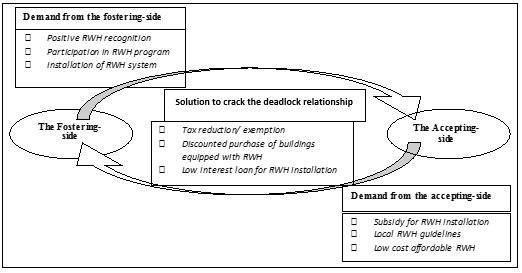
Conclusion
RWH could provide a long-term solution to promote water conservation for Total Water Resources Management (TWRM) in Malaysia. Results from the social surveys conducted by structured interviews among the fostering-side and questionnaire surveys among the accepting-side concludes that in general both parties are interested in implementing RWH. However, the fostering-side expects the cooperation from the accepting-side mainly in term of participation in RWH programs including installation of RWH system in their respective premises, while the accepting-side demands the fostering-side to undertake several moves that would enable them to easily implement RWH. Among the demands are on providing subsidies for RWH installation, the enforcement of relevant RWH regulation and to ensure the availability of affordable low cost RWH products in the local market. This has created a deadlock relationship between the parties as they each expect the other party to step up and make the first move before them. These challenges lead to impending of widespread RWH implementation. Therefore, reward-based RWH application and attractive offers including discounted purchasing of buildings equipped with RWH, product development and capacity building are anticipated to provide solution to the deadlock relationship, thereby ensuring more effective implementation of RWH in future.
References
- Aliagha, G. U., Hashim, M., Sanni, A. O., & Ali, K. N. (2013). Review of green building demand factorsn for Malaysia. Journal of Energy Technologies and Policy, 3(11), 471-478.
- Bates, B., Kundzewicz, Z., & Wu, S. (2008). Climate change and water. Intergovernmental Panel on Climate Change Secretariat.
- Basheer, A. O., Hanafiah, M. M., & Abdulhasan, M. J. ( 2017). A Study on water quality from Langat River, Selangor.
- Bernama. (2014, 28 April 2014). Only Six States Taking Up Rainwater Harvesting, Newspaper. The Sun Daily. Retrieved from http://www.thesundaily.my/news/1030632
- Chan, N. W. (2009). Issues and challenges in water governance in Malaysia. ranian Journal of Environmental Health Science & Engineering, 6(3), 143-152.
- Hashim, S. Z., Zakaria, I. B., Ahzahar, N., Yasin, M. F., & Aziz, A. H. (2016). Implementation of green building incentives for construction key players in Malaysia. International Journal of Engineering and Technology (IJET), 8(2), 1–6.
- Jeewan, P., Thanju, & Bashanta, D. S. (2010 ). Rain Water Harvesting in Kathmandu. Hydro Nepal (No. 7), 24-25.
- Jung, K., Lee, T., Choi, B. G., & Hong, S. (2015). Rainwater harvesting system for contiunous water supply to the regions with high seasonal rainfall variations. Water Resources Management, 3(29), 961–972. doi:DOI 10.1007/s11269-014-0854-1
- Karim, M. R., Shelly, A. B., & Biswas, M. (2005). People perception and acceptance of rainwater harvesting in a coastal area in Bangladesh. 12th International Rainwater Catchment Systems Conference New Delhi, India.
- Nafisah, A. R., Matsushita, J., & Okada, A. (2011). Evaluation of the effects and the programming of 'Water Conservation Plan' (WCP) for total water resources management in Tokyo. Journal of Water and Environment Technology, 9(2), 179-197. doi:http://doi.org/10.2965/jwet.2011.179
- Nafisah, A. R., Matsushita, J., & Suenobu, K. (2011). Assessment on total water resources management (TWRM) in Selangor, Malaysia with emphasis on rainwater harvesting in the basis of lessons learned from Tokyo’s TWRM. Journal of Japan Society of Shimanto Policy and Integrated River Basin Management, 10(2), 51-60.
- OECD. (2017). Diffuse pollution, degraded waters: emerging policy solutions. doi:http://dx.doi.org/10.1787/9789264269064-en
- Palinkas, L. A., Horwitz, S. M., Green, C. A., Wisdom, J. P., Duan, N., & Hoagwood, K. (2013). Purposeful sampling for qualitative data collection and analysis in mixed method implementation research. Adm Policy Ment Health. doi:DOI 10.1007/s10488-013-0528-y
- Rahman, S., Khan, M. T. R., Akib, S., Din, N. B. C., Biswas, S. K., & Shirazi4, S. M. (2014). Sustainability of rainwater harvesting system in terms of water quality. The Scientific World Journal. doi:http://dx.doi.org/10.1155/2014/721357
- Shaaban, A. J., & Appan, A. (2007). Utilising rainwater for non-potable domestic uses and reducing peak urban runoff in Malaysia, XI International Rainwater Catchment System Association Conference. Retrieved from http://www.eng.warwick.ac.uk/ircsa/pdf/11th/binshaaban.pdf
- Star, T. (25 Jun 2013). Tapping free flows. The Star.
- Sukereman, A. S., & Suratman, R. (2016). Potential of best management practices (bmps) projects for effective integrated water resource management. Sains Humanika, 8(4-3).
- Ward, S., Butler, D., & Memon, F. (2008). A pilot study into attitudes towards and perceptions of rainwater harvesting in the UK. BHS 10th National Hydrology Symposium, Exeter.
- Willis, R. M., Stewart, R. A., Panuwatwanich, K., Williams, P. R., & Hollingsworth, A. L. (2011). Quantifying the influence of environmental and water conservation attitudes on household end use water consumption. J Environ Manage, 92(8), 1996-2009. doi:10.1016/j.jenvman.2011.03.023
Copyright information

This work is licensed under a Creative Commons Attribution-NonCommercial-NoDerivatives 4.0 International License.
About this article
Publication Date
01 May 2018
Article Doi
eBook ISBN
978-1-80296-039-6
Publisher
Future Academy
Volume
40
Print ISBN (optional)
-
Edition Number
1st Edition
Pages
1-1231
Subjects
Business, innovation, sustainability, environment, green business, environmental issues
Cite this article as:
Rahiman, N. A., Matsushita, J., Ariffin, H. L. T., Shukery, N. M., & Mahmud, S. H. (2018). Rainwater Harvesting In Malaysia: A Survey On Fostering-Side And Accepting-Side. In M. Imran Qureshi (Ed.), Technology & Society: A Multidisciplinary Pathway for Sustainable Development, vol 40. European Proceedings of Social and Behavioural Sciences (pp. 460-473). Future Academy. https://doi.org/10.15405/epsbs.2018.05.37

